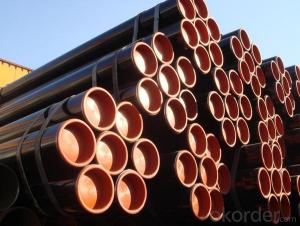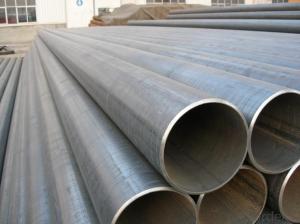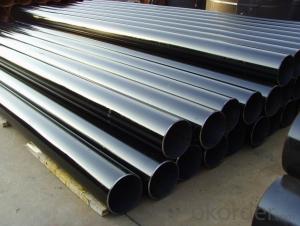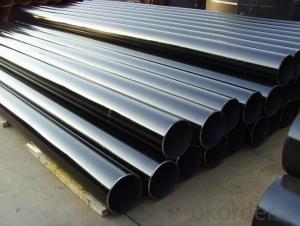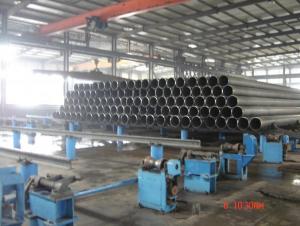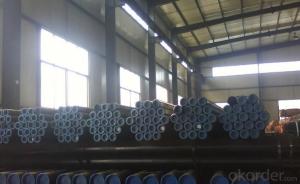high quality api 5ct erw steel pipe
- Loading Port:
- China Main Port
- Payment Terms:
- TT OR LC
- Min Order Qty:
- -
- Supply Capability:
- -
OKorder Service Pledge
OKorder Financial Service
You Might Also Like
WELDED ROUND STEEL PIPE
Commodity | Steel Pipe and Tube | ||
Features |
OD(mm) |
Thickness(mm) |
Length(m) |
Cross-sectional | |||
Round: | 21.3-273.1 | 1.0-9.5 | 5.8/6 or you require |
Square: | 15*15-300*300 | 1.0-15.0 | 5.8/6 or you require |
Rectangular: | 10*15-350*400 | 1.0-15.0 | 5.8/6 or you require |
National Standard | |||
Welded Steel Pipe For Transportation Of Low Pressure Fluid | |||
GB/T13091-2001 | |||
1 | Outside Diameter Of Steel Pipe | ||
Outside Diameter D/mmm | Tolerance Of Pipe Outside Diameter | Tolerance Of Pipe And Outside Diameter/mm | |
D≤48.3 | ±0.5mm |
| |
48.3<D≤508 | ±1.0% |
| |
168.3<D≤508 | ±0.75% | +2.4 -0.8 | |
D>508 | ±1.0% | +3.0 -0.8 | |
Tolerance Of Wall Thickness | ±12.5% | ||
2 | Length | Usual Length | Tolerance |
4M-9M | +20 -0 | ||
Multiple Length:5-10mm Tolerance For Each Mutiple | +20 -0 | ||
3 | Bending | ≤168.3mm | Straight For Ordinary Use Or Negotiate The Bending |
>68.3mm | Smaller Than 0.2%Of Full Length Steel Pipe | ||
Nominal Pipe size (inch) | Outside Diameter (mm) | Schedule 1 | ||
Nominal Wall Thickness (mm) | Weight(kg/m) | |||
Small |
Big
| |||
1/2” | 20 | 1.0-2.75 | 0.467 | 1.168 |
3/4” | 25 | 0.9-2.75 | 0.662 | 1.55 |
1” | 32 | 1.0-3.25 | 0.693 | 2.341 |
11/4 | 40 | 1.0-3.25 | 1.24 | 2.945 |
11/2 | 47 | 1.0-3.5 | 1.367 | 3.5 |
2 | 59 | 1.5-3.5 | 3.758 | 4.716 |
21/2 | 75 | 1.5-3.75 | 2.718 | 6.588 |
3 | 88 | 1.8-3.75 | 3.825 | 7.79 |
4 | 114 | 1.5-4.0 | 4.16 | 10.85 |
5 | 140 | 2.5-4.25 | 8.476 | 14.227 |
6 | 165 | 2.5-4.5 | 10.017 | 17.717 |
8 | 219 | 3.5-5.0 | 18.572 | 26.385 |
- Q: Who knows what is the difference between double submerged arc welded pipe and longitudinal submerged arc welding?
- Double submerged arc welding should be for spot welding and single side welding, they are straight line welds, but double submerged arc welding seam is more beautiful and fine.
- Q: Are steel pipes resistant to corrosion?
- Yes, steel pipes are generally resistant to corrosion due to the protective layer of oxide that forms on their surface, but their resistance can vary depending on the specific grade of steel and the environment they are exposed to.
- Q: How are steel pipes graded?
- Steel pipes are graded based on various factors such as the composition of steel, manufacturing process, and physical properties like strength, durability, and corrosion resistance. These grades are assigned based on internationally recognized standards such as ASTM, API, and ISO, which provide specific criteria for different applications and industries.
- Q: Seamless steel pipe is how to do it?
- 1. seamless steel tubes for structural purposes (GB/T8162-1999) are seamless steel tubes for general structural and mechanical construction.2. seamless steel pipe for fluid transportation (GB/T8163-1999) is used to transport water, oil, gas and other fluids of general seamless steel pipe.3. seamless steel tubes for low and medium pressure boiler (GB3087-1999) is used in the manufacture of various structures of low and medium pressure boiler superheated steam pipe, superheated steam pipe, boiling water pipe and boiler flue tube, pipe and brick arch tubes of high quality carbon steel hot rolling and cold drawing (rolling) seamless steel tube.4. high pressure boiler seamless steel tube (GB5310-1995) is used for the manufacture of high-pressure and above the pressure of water boiler heating surface for high-quality carbon steel, alloy steel and stainless steel heat-resistant seamless steel pipe.5. high pressure seamless steel tube (GB6479-2000) for chemical fertilizer equipment is a kind of high quality carbon structural steel and alloy steel seamless pipe for chemical equipment and pipes of working temperature of -40~400 DEG C and working pressure of 10~30Ma.6. seamless steel tubes for petroleum cracking (GB9948-88) are tubes, heat exchangers and seamless steel tubes used in refineries.
- Q: How do you select the right size of steel pipe for a project?
- To select the right size of steel pipe for a project, one must consider factors such as the intended purpose, the flow rate or pressure requirements, the material being transported, and any applicable building codes or regulations. Consulting engineering specifications, pipe size charts, and professional advice can help in determining the appropriate size that will meet the project's requirements and ensure optimal performance and safety.
- Q: How are steel pipes used in nuclear power plants?
- Steel pipes are used in nuclear power plants for various purposes, including transporting coolant, steam, and other fluids, as well as providing structural support for the plant's infrastructure.
- Q: How are steel pipes used in the construction of nuclear power plants?
- Steel pipes are widely used in the construction of nuclear power plants for various critical applications. They are employed in the primary coolant system, where they carry and circulate the pressurized water or liquid metal coolant that transfers heat from the reactor core to the steam generator. Steel pipes are also utilized in the secondary coolant system, which transports the generated steam to drive the turbine for electricity production. Additionally, steel pipes are used for the construction of various auxiliary systems, such as the emergency cooling system or the ventilation system, ensuring the safe and efficient operation of nuclear power plants.
- Q: How do steel pipes handle water hammer in high-rise buildings?
- Steel pipes in high-rise buildings are designed to handle water hammer by incorporating various features. Firstly, these pipes are often equipped with pressure relief valves or surge tanks that absorb and dissipate the sudden pressure changes caused by water hammer. Additionally, engineers use techniques such as proper pipe sizing, installation of air chambers, and use of flexible connectors to minimize the effects of water hammer. These measures help to reduce the sudden pressure spikes and prevent damage to the pipes and other plumbing components in high-rise buildings.
- Q: Can steel pipes be used for underground sewage treatment plants?
- Yes, steel pipes can indeed be used for underground sewage treatment plants. Steel pipes are commonly used in underground applications due to their durability, strength, and resistance to corrosion. They are capable of withstanding the harsh underground environment and can efficiently transport sewage from one area to another within the treatment plant. Moreover, steel pipes can be customized to meet the specific requirements of the sewage treatment plant, such as different diameters and wall thicknesses, ensuring proper flow and drainage. Additionally, steel pipes can be coated or lined with protective materials to enhance corrosion resistance, further extending their lifespan. Overall, steel pipes are a reliable and suitable choice for underground sewage treatment plants.
- Q: How are steel pipes used in structural applications?
- Steel pipes are commonly used in structural applications due to their strength, durability, and versatility. They are often used as columns, beams, and braces in buildings, bridges, and other structures. Steel pipes provide excellent load-bearing capacity and can withstand high levels of stress and pressure, making them ideal for supporting heavy loads. Additionally, their hollow cylindrical shape allows for easy installation and provides space for utilities such as electrical wiring or plumbing. Overall, steel pipes contribute to the stability and integrity of structures, ensuring their safety and longevity.
Send your message to us
high quality api 5ct erw steel pipe
- Loading Port:
- China Main Port
- Payment Terms:
- TT OR LC
- Min Order Qty:
- -
- Supply Capability:
- -
OKorder Service Pledge
OKorder Financial Service
Similar products
Hot products
Hot Searches
Related keywords
